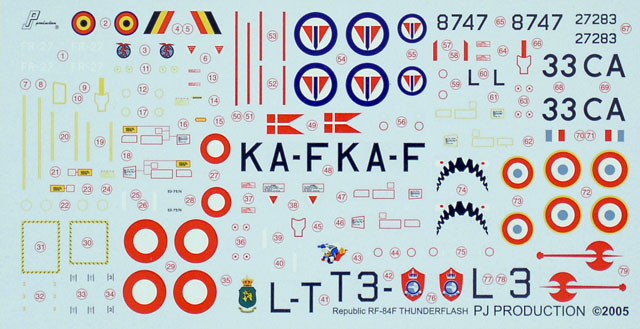In June 1955,
the production line of the RF-84F-20-RE was equipped with a Wright
J65-W-7 jet. Deliveries of the RF-84F Thunderflash began in March 1954,
initially to the 363RD TRW at Shaw AFB in North Carolina. More than 715
RF-84Fs were delivered from Farmingdale until January 1958. The United
States quickly re-equipped more than 12 Squadrons with the new RF-101,
and NATO countries also received and operated this type. We find the
RF-84F on the apron of the West German, Belgian, Italian, Danish,
Norwegian, Turkish, Greek Air Forces. France also received this version,
put in service with the « 33 » Wing, Belfort, Moselle, and Savoie
squadrons.
The Kit
After his
superb 1/72 scale F-84F, the famous craftsman from Belgium come back
this time with the recon version of this elegant ’50 jet. As always,
the quality is at the rendez vous.

If a lot of
parts are common with the first box, the main differences are also
evident at first glance, with the new nose and the intakes on the
wings. But the other differences are depicted too - the wider wings,
two typical different ejection seats, the forward gear bay, the
dashboard (with the special scope), and the fences on the upper wings.
Assembly
starts with the canopy and the choice of the seats, the instrument panel
and the control stick. The L/R consoles are molded on the internal
fuselages(you’ll need to add hooks for the closing canopy system,
according to the Squadron in action drawings ), Everything is closed
there with the exhaust at the rear.
The front
area containing cameras and gear is a four part assembly with
upper/under nose section (transparent lower part will be polish before
painted in black ), transparent tip nose , and internal bay. Even if
nothing is really seen through at this scale, one eventually will be
able to simulate the lens cameras with small scale cars lenses from
accessories range.
The wings and
the air intakes match with precision thanks to guides on the fuselage.
The last big work deal with the rudder and the stabilisators, leaving
the other little bits, gears, open airbrakes with excellent P/E details,
and fuels tanks for last stage assembly as usual, avoiding breaking
parts.
Four marking
options are included. The choice is interesting with European machines,
Norwegian, Danish, and France (1/33 Belfort) in bare natural metal, and
a Belgian machine in SEA camo (the L/R/Upper camo pattern is on the
notice with the usual range of painting crossing guide references).
Nothing to say about them really, except good register and well aligned.

In summary,
here again is a 10 out of 10 rating for this excellent model designed by
PJ Production. You can now forget the other models available in this
scale from any manufacturers!
Home | What's
New | Features
| Gallery |
Reviews | Reference
| Forum
| Search